Can what cannot be measured exactly happen exactly?
Jaki’s criticism
of the Copenhagen interpretation of quantum theory
John Long, ISCAST Australia and Deakin University
Speech delivered at Seton Hall University, on April 24, 2024
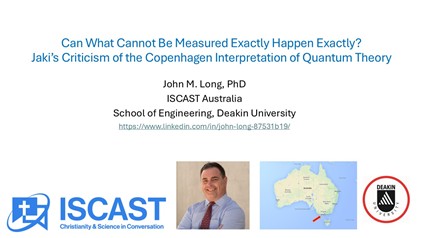
I wish to sincerely thank the Jaki Congress committee for giving me the opportunity to give this talk. Mine is perhaps an unusual story. I grew up in southern Michigan, completing undergraduate studies in 1987 at University of Michigan in Flint. I completed a double major in philosophy and physics, and subsequently trained in material science.
I confess that I know only enough of philosophy to be dangerous; but it’s enough to be able to read Stanley Jaki’s books and more-or-less understand them. My scientific training is not particle physics, nor cosmology. It’s materials science. [1] I spent much of my career in laboratories measuring things. So I am not a high-end physicist, nor a philosopher, nor a historian. I'm a humble country physicist who has found Jaki’s books inspiring and informative.
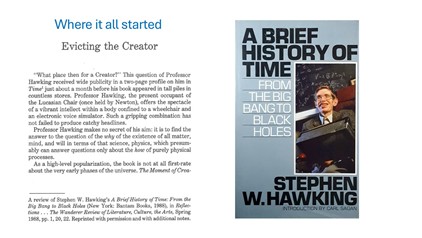
In 1988 I started doctoral studies at Monash University in Melbourne. About that time I stumbled onto Father Jaki’s review of Stephen Hawkings book A Brief History of Time. [2] This book lined all the bookshelves at the time, certainly the ones that I hung around. I read Father Jaki’s review. It was brutal as I will explain. I thought, “Who is this guy who dares to criticise Professor Stephen Hawking, perhaps the best-known physicist on the planet?” Well that was the start. I have been studying Jaki’s works ever since.
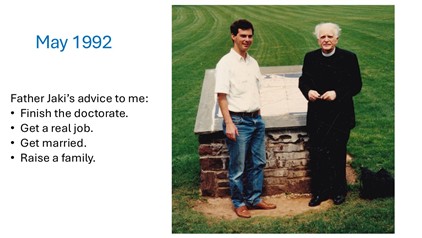
In 1992 on a visit home I looked him up and happily, he gave me some of his time. I told him that I found his work inspiring and wouldn't mind going into a similar field. His advice to me was polite, but stern, and probably quite sound. He advised me to finish my doctorate, get a real job, get married, and raise a family.
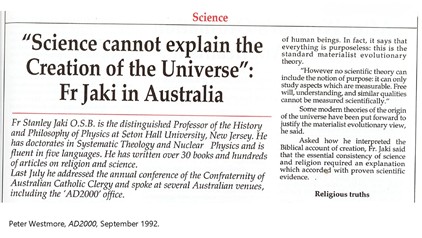
A couple months later he visited Australia and gave lectures in Sydney, Canberra, Melbourne, and Wagga Wagga. [3] I attended his lecture in Melbourne, and surprisingly, he remembered who I was. In his books, Jaki has a lot to say about physics, and I find it very interesting.
Onto the topic of this talk, which is to review what Jaki has to say about how quantum theory in physics has been interpreted. No surprise I guess, in that many physicists are interpreting it all wrong, at least philosophically. He used Hawking’s book as a reason to explain why. He did this over and over in his books, so he felt pretty strongly about it.
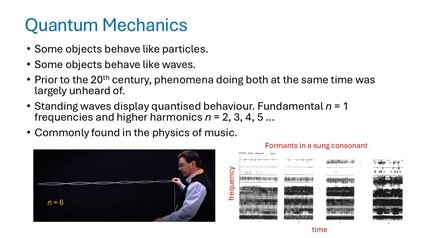
Here is the shortest lesson I will ever give about quantum mechanics. In physics, some objects behave like particles and some behave like waves. [4] In wave behaviour we observed that when two or more waves interact, resonance effects take place such that the frequencies of resonance are integer multiples of some fundamental frequency. These are called harmonics, and physicists would say that the harmonic frequencies are quantized. We find integer multiples 1, 2, 3, 4... and so on in the equations. Musicians see this too because the harmonics are related to octaves and overtones. [5] And good musicians with good instruments are trained to produce those harmonics because they make the music richer and less “tinny”.
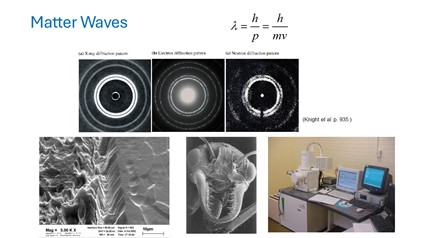
20th century physics showed that particles also have wave-like properties, but we only observe that in atomic sized particles or smaller. Electron microscopy is the classic application of particles acting as waves.
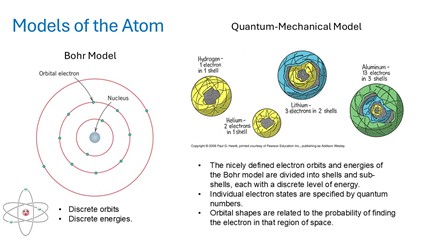
Our understanding of the atom went through some very significant development in the early part of the 1900s. For our purposes here, we can start with Niels Bohr’s model of the atom which was a nucleus and around the nucleus particle-like electrons circulated in orbits corresponding to various energies. [6] That was the last model where the atom was treated only as a particle. Quantum theory came along with the theory of matter waves, and the structure of the atom got a whole lot more complicated. Instead of electron particles moving in tiny orbits, the electrons act as resonating waves. We called the electron states orbitals, and describe them with wave mechanics instead of particle mechanics. [7]
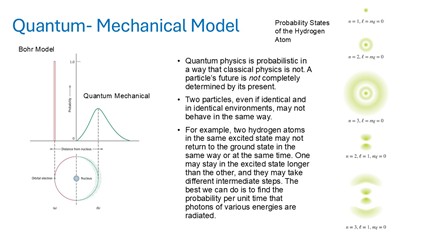
This is where things get messy. Because the electron is now seen as a wave, we have to use probabilities to describe its behaviour. In classical physics we can accurately predict an object’s later state if we know its initial state, usually by applying Newton’s laws. In quantum mechanics that is not so easy. We can predict energy states and changes in energy, but we cannot predict which electron is going to change state or when. Again this is because at the atomic level, particles behave like waves, and to describe them we have to use wave equations.
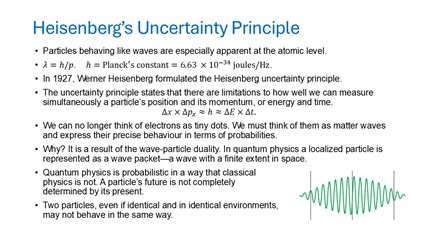
Now the German physicist Werner Heisenberg comes in. His famous uncertainty principle states that there are limitations to how well we can simultaneously measure a particle’s position and its momentum. We can no longer think of electrons as tiny dots. We have to think of them as matter waves and use probabilities to predict their behaviour. Some experiments can measure particle-like properties, other experiments measure wave-like properties. But we can't do both at the same time in the same experiment. Bohr called this the “principle of complementarity” two sides to a coin — one side particles, the other waves. [8]

One very common interpretation is called the Copenhagen interpretation. It’s the one most often found in physics books. This interpretation takes our inability to measure some aspects of atomic particles and attributes that to reality itself. The upshot is that this interpretation says that quantum mechanics proves that ontological cause and effect are invalid, meaningless. Here is a selection of common statements from a few physics books:
• “Quantum mechanics does not allow complete determinism. The uncertainty principle places a fundamental limit on the precision with which the position and momentum can simultaneously be known”. [9]
• “Quantum theory therefore abandons strict causality in individual events in favor of a fundamentally statistical interpretation of their collective regularity... The law of causation, according to which the course of events in an isolated system is completely determined by the state of the system at [time] t = 0, loses its validity in quantum theory”. [10]
• “The uncertainty principle signaled an end to [the] dream of a theory of science, a model of the universe that would be completely deterministic: One certainly cannot predict future events exactly if one cannot even measure the present state of the universe precisely!” [11]
• “Since all experiments are subjected to the laws of quantum mechanics and thereby to the [uncertainty] equation, the invalidity of the law of causality is definitely proved by quantum mechanics. [12]
This leads to Jaki’s one-line summary of the Copenhagen interpretation, and the title of this talk: “What cannot be measured exactly cannot happen exactly”. This simple eight-word sentence shook physics to his philosophical foundations.
Father Jaki criticised this statement over and over again. He traces the underlying philosophy of the Copenhagen interpretation through 19th-century German idealism to Immanuel Kant. Jaki says that the Copenhagen interpretation makes a fundamental error in logic, and he puts his finger on it.
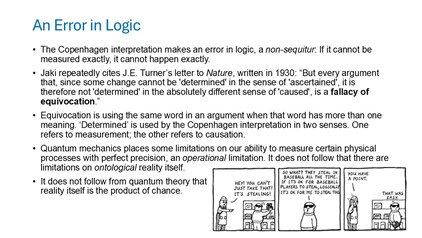
The statement “what cannot be measured exactly cannot happen exactly” is a non sequitur, an error in logic. Specifically, it is a fallacy of equivocation. Equivocation is where one word with two meanings is used in the same logical argument. [13] ‘Determined’ is the keyword. Jaki says that in quantum mechanics ‘determined’ means ‘measured’. In the Copenhagen interpretation it means ‘caused’ An operational limitation in measurement becomes an ontological property of reality itself.
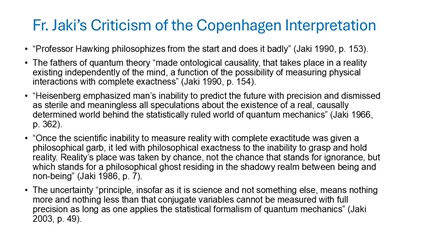
Some of his more poignant statements are worth recalling:
• “Professor Hawking philosophizes from the start and does it badly”. [14]
• The fathers of quantum theory “made ontological causality, that takes place in a reality existing independently of the mind, a function of the possibility of measuring physical interactions with complete exactness”. [15]
• “Heisenberg emphasized man’s inability to predict the future with precision and dismissed as sterile and meaningless all speculations about the existence of a real, causally determined world behind the statistically ruled world of quantum mechanics”. [16]
• “Once the scientific inability to measure reality with complete exactitude was given a philosophical garb, it led with philosophical exactness to the inability to grasp and hold reality. Reality’s place was taken by chance, not the chance that stands for ignorance, but which stands for a philosophical ghost residing in the shadowy realm between being and non-being”. [17]
• The uncertainty “principle, insofar as it is science and not something else, means nothing more and nothing less than that conjugate variables cannot be measured with full precision as long as one applies the statistical formalism of quantum mechanics”. [18]
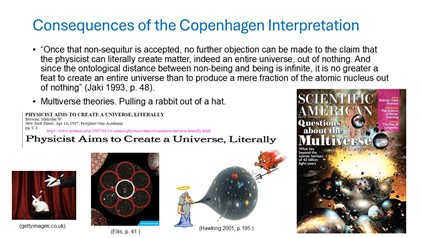
As a consequence of this interpretation Jaki says that not only do some physicists claim that subatomic particles can spontaneously appear from nothing, some cosmologists (Hawking included) claim that a whole universe can pop into being from nothing, spontaneously. [19] Needless to say, Jaki was very strong in his criticism of this position. At its extreme is the multiverse theory, proposed by Hawking and others. [20] Jaki called it pulling a rabbit out of a hat.
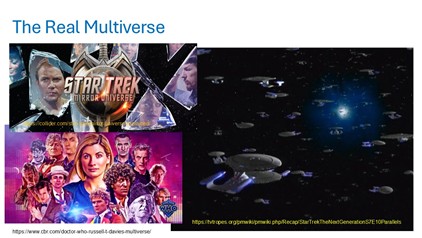
So where in reality do we find multiple universes popping up spontaneously through quantum singularities? I find them in comic books, television shows, and movies. They make for great science fiction, and make it easier for writers to keep producing stories about their favourite superheroes without worrying too much about continuity with past stories.
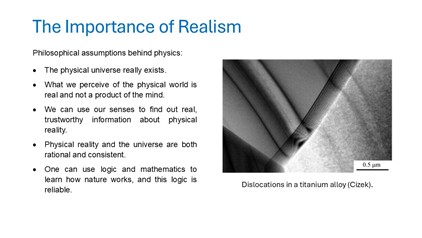
As I understand it Jaki’s philosophy is a middle way between a priori rationalism and a posteriori empiricism. He called it moderate realism. In his writings, moderate realism forms the philosophical foundation for physics and all the sciences. His book The Relevance of Physics summarises the philosophical assumptions supporting physics:
• The physical universe really exists.
• What we perceive of the physical world is real and not a product of the mind.
• We can use our senses to find out real, trustworthy information about physical reality.
• Physical reality and the universe are both rational and consistent.
• One can use logic and mathematics to learn how nature works, and this logic is reliable.
For me, a practising lab rat and physics teacher, this is important. It is important not just for my peace of mind or to bolster my faith as a Christian. In the past few years I have seen non realist philosophies trying to creep into STEM (science, technology, engineering, and maths) education, including physics.
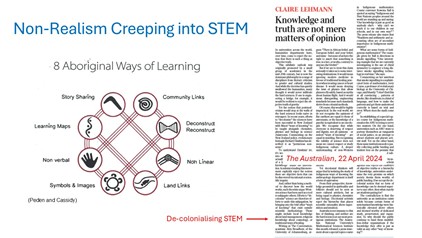
In Australia there is an educational movement underway to introduce “indigenous ways of knowing” into education. It appears to have been around for a while in primary and secondary social-science education, but lately I see it creeping into STEM at the tertiary level. [21] Decolonialising science, technology, engineering, and maths appears to be a new buzz phrase. [22] Father Laracy thinks it is wriggling its way into theories of cybernetics, control and computer science. [23] I see it in the physics education literature. [24] This has been only in the past five years, and it looks to be gaining momentum. I hope it is only another passing fad. If and when non-realist philosophy takes over engineering, I think we are in trouble. Reality can be very blunt, especially in engineering.
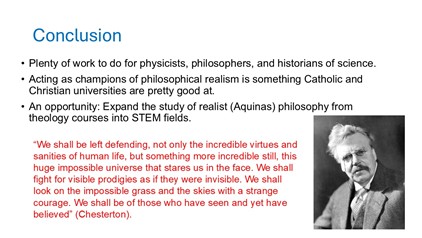
Let’s wrap this up. My written paper suggests a lot of further work to consider from Father Jaki’s arguments. There is plenty to keep physicists, philosophers and historians busy. I would love to see his thought incorporated into education. I would love to see realism taught as much in education as positivism and constructivism are taught. And I would love to see the study of realism (meaning Aquinas) expanded from Christian theology schools into STEM education. If my concerns are accurate, STEM is going to need it.
My final words quote Gilbert Chesterton. At the end of his book Heretics, his words are proving to be prophetic, and groups like this one might need to shout them from the rooftops. In his final statement, Chesterton said:
“We shall be left defending, not only the incredible virtues and sanities of human life, but something more incredible still, this huge impossible universe that stares us in the face. We shall fight for visible prodigies as if they were invisible. We shall look on the impossible grass and the skies with a strange courage. We shall be of those who have seen and yet have believed.” [25]
Father Stanley Jaki certainly did this. And those of us who count as his students should do the same. We should be among those leading the charge.

Thank you!
[1] S. L. Jaki, "The Relevance of Materials Science," Ferroelectrics, vol. 267, no. 1, pp. 77-89, 2002. Reprinted in Numbers Decide and Other Essays, Pinckney, MI: Real View Books, 2003, pp. 181-190.
[2] S. L. Jaki, "Evicting the Creator," in The Only Chaos and other Essays, Lanham, MD: University Press of America, 1990, ch. 10, pp. 152-161.
[3] P. Westmore, "'Science can't Explain Creation of the Universe' - Fr. Stanley Jaki in Australia," AD2000, vol. 5, no. 8, p. 9, September 1992. Available here.
[4] R. D. Knight, B. Jones, and S. Field, College Physics: a Strategic Approach, 3rd ed. Boston: Pearson, 2015.
[5] I. Johnston, Measured Tones: The Interplay of Physics and Music, Bristol, UK: Adam Hilger, 1989.
[6] W. D. Callister and D. G. Rethwisch, Materials Science and Engineering: An Introduction, New York: Wiley, 2010.
[7] P. G. Hewitt, Conceptual Physics, San Francisco: Pearson Addison Wesley, 2006.
[8] D. Halliday, R. Resnick, and J. Walker, Fundamentals of Physics, 11th ed. New York: Wiley, 2018.
[9] A. Giambattista, Physics, 5th ed. New York: McGraw Hill, 2020.
[10] R. Resnick, Basic Concepts in Relativity and Early Quantum Theory, New York: Wiley, 1972.
[11] S. Hawking, A Brief History of Time: From the Big Bang to Black Holes, New York: Bantam, 1988, p. 55.
[12] Heisemberg, quoted in S. L. Jaki, The Relevance of Physics, Chicago: The University of Chicago Press, 1966, p. 362.
[13] I. M. Copi, Introduction to Logic, 5th ed. New York: Macmillan, 1978.
[14] S. L. Jaki, "Evicting the Creator," in The Only Chaos and other Essays, Lanham, MD: University Press of America, 1990, ch. 10, p. 153.
[15] S. L. Jaki, The Only Chaos and other Essays, Lanham, MD: University Press of America, 1990, p. 154.
[16] S. L. Jaki, The Relevance of Physics, Chicago: The University of Chicago Press, 1966, p. 362.
[17] S. L. Jaki, "Chance or Reality: Interaction in Nature versus Measurement in Physics," in Chance or Reality and other Essays, Lanham, MD: University Press of America, 1986, p. 7.
[18] S. L. Jaki, Numbers Decide and other Essays, Pinckney, MI: Real View Books, 2003, p. 49.
[19] S. Hawking, The Universe in a Nutshell, New York: Bantam, 2001.
[20] F. R. Ellis, "Does the Multiverse Really Exist?," Scientific American, vol. 305, no. 2, pp. 38-43, 01 August 2011. Available here.
[21] K. Peden and S. J. Cassidy, "Excavating bridges for future streams," Australian Physics, vol. 59, no. 1, pp. 17-23, 2022.
[22] C. Lehmann, "Knowledge and Truth are not Mere Matters of Opinion," in The Australian, ed, 2024, p. 13.
[23] J. T. Laracy and J. R. Laracy, "Reconceiving Cybernetics in Light of Thomistic Realism," Systemics, Cybernetics and Informatics, vol. 19, no. 4, pp. 24-39, 2021.
[24] N. Govender and E. Mudzamiri, "Incorporating Indigenous Artefacts in Developing an Integrated Indigenous-Pedagogical Model in High School Physics Curriculum: Views of Elders, Teachers and Learners," Cultural Studies of Science Education, vol. 17, no. 3, pp. 827-850, 2022.
[25] G. K. Chesterton, Heretics, San Francisco: Ignatius Press, 1986.